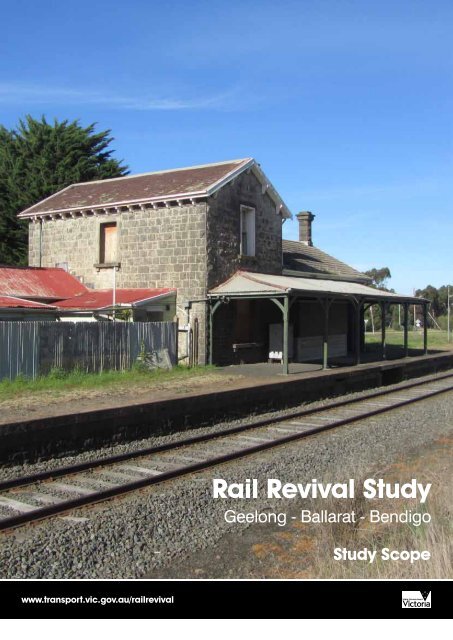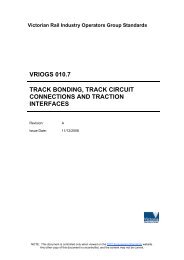Rail Revival Study - Scope - Public Transport Victoria
Rail Revival Study - Scope - Public Transport Victoria
Rail Revival Study - Scope - Public Transport Victoria
You also want an ePaper? Increase the reach of your titles
YUMPU automatically turns print PDFs into web optimized ePapers that Google loves.
<strong>Rail</strong> <strong>Revival</strong> <strong>Study</strong><br />
Geelong - Ballarat - Bendigo<br />
<strong>Study</strong> <strong>Scope</strong><br />
www.transport.vic.gov.au/railrevival
<strong>Rail</strong> <strong>Revival</strong> <strong>Study</strong><br />
Geelong - Ballarat - Bendigo<br />
This publication is copyright. No part may be reproduced<br />
by any process except in accordance with the provisions<br />
of the Copyright Act 1968.<br />
© State of <strong>Victoria</strong> 2011<br />
Authorised by the <strong>Victoria</strong>n Government, 121 Exhibition St,<br />
Melbourne <strong>Victoria</strong> 3000.<br />
Printed by XXXXXXXXXXXXXXX.<br />
If you would like to receive this publication in an accessible<br />
format, such as large print or audio please telephone <strong>Public</strong><br />
Affairs Branch, Department of <strong>Transport</strong> on (03) 9655 6000.<br />
2 <strong>Rail</strong> <strong>Revival</strong> <strong>Study</strong> Geelong - Ballarat - Bendigo
<strong>Rail</strong> <strong>Revival</strong> <strong>Study</strong><br />
Geelong – Ballarat – Bendigo<br />
Inglewood<br />
To Robinvale<br />
Bridgewater<br />
To Swan Hill<br />
To Echuca<br />
Eaglehawk<br />
Epsom<br />
Legend<br />
To Mildura<br />
Dunolly<br />
Maryborough<br />
To Ararat<br />
Talbot<br />
Carisbrook<br />
Moolort<br />
Maldon<br />
Distance: 55 km<br />
Newstead<br />
Kangaroo Flat<br />
<strong>Victoria</strong>n<br />
Goldfields<br />
<strong>Rail</strong>way<br />
Distance: 37 km<br />
Harcourt<br />
Bendigo<br />
Golden Square<br />
Castlemaine<br />
Campbell’s Creek<br />
Guilford<br />
Regional City<br />
Township (with active station)<br />
Township (publicly disused station)<br />
Disused track<br />
Roads<br />
Regional <strong>Rail</strong> Link<br />
Sections<br />
Geelong – Ballarat<br />
Ballarat – Maryborough<br />
Maryborough – Castlemaine<br />
Melbourne – Bendigo <strong>Rail</strong>way<br />
Distance: 69 km<br />
Castlemaine – Bendigo<br />
Clunes<br />
To Ararat<br />
Creswick<br />
Ballarat<br />
To Seymour<br />
Melbourne – Ballarat <strong>Rail</strong>way<br />
Lal Lal<br />
N<br />
To Ararat<br />
Distance: 87 km<br />
Meredith<br />
Lethbridge<br />
Bannockburn<br />
Bell Post Hill<br />
Melbourne – Geelong <strong>Rail</strong>way<br />
Melbourne<br />
North Geelong<br />
To Warrnambool<br />
Geelong<br />
www.transport.vic.gov.au<br />
<strong>Rail</strong> <strong>Revival</strong> <strong>Study</strong> Geelong - Ballarat - Bendigo 3
1. Purpose<br />
The purpose of this document is to outline the scope<br />
of the <strong>Rail</strong> <strong>Revival</strong> <strong>Study</strong>: Geelong-Ballarat-Bendigo<br />
and provide an understanding of the study’s timing,<br />
project deliverables and governance arrangements.<br />
Echuca<br />
Numurkah<br />
Yarrawonga<br />
Tongala<br />
2. Background<br />
The <strong>Victoria</strong>n Government has allocated $2 million to<br />
examine the long-term feasibility of returning passenger<br />
trains between Geelong, Ballarat and Bendigo (via<br />
Meredith, Maryborough & Castlemaine) – <strong>Victoria</strong>’s<br />
second, third and fourth largest cities.<br />
This study forms part of the <strong>Victoria</strong>n Government’s<br />
<strong>Transport</strong> Solutions framework, which aims to boost<br />
the efficiency and productivity of <strong>Victoria</strong>n industry and<br />
enhance regional growth.<br />
In undertaking the study, the <strong>Victoria</strong>n Government will<br />
reference relevant regional strategic plans developed<br />
by local councils and communities. These describe<br />
key challenges and priorities for local government and<br />
communities in the ‘Midland Arc’ region, and include the:<br />
• Central Highlands Regional Strategic Plan;<br />
• Southern Loddon Mallee Regional Strategic Plan; and<br />
• G21 Regional Strategic Plan.<br />
These plans highlight the importance of identifying<br />
opportunities within the ‘Midland Arc’ to manage and<br />
facilitate settlement growth and regional development.<br />
They also articulate short, medium and longer term<br />
priorities to enhance freight and public transport<br />
connectivity in this region.<br />
Kyabram<br />
Rochester<br />
Shepparton<br />
Tatura<br />
Elmore<br />
Inglewood Goornong<br />
Murchison<br />
Rushworth<br />
Benalla<br />
Huntly<br />
Violet Town<br />
Eaglehawk<br />
Toolleen<br />
Euroa<br />
Bendigo<br />
Dunolly<br />
Heathcote<br />
Maldon<br />
Castlemaine<br />
Maryborough<br />
Mansfield<br />
Talbot<br />
Legend<br />
Clunes<br />
Kilmore<br />
Regional City<br />
Daylesford<br />
Township<br />
Miners Rest Creswick<br />
Roads<br />
Gisborne<br />
Whittlesea<br />
<strong>Rail</strong><br />
Ballarat<br />
Sunbury<br />
Bacchus Marsh<br />
Buninyong<br />
Midland arc<br />
Lilydale<br />
Melbourne<br />
Werribee<br />
Dandenong<br />
Cressy<br />
Geelong<br />
Frankston<br />
Warragul<br />
N<br />
Queenscliff<br />
Colac<br />
Rosebud<br />
Anglesea<br />
Leongatha<br />
Lorne<br />
4 <strong>Rail</strong> <strong>Revival</strong> <strong>Study</strong> Geelong - Ballarat - Bendigo
3. History<br />
Geelong – Ballarat<br />
1862 The railway from Geelong to Ballarat was<br />
opened, operating as the main passenger<br />
line between Melbourne and Ballarat<br />
1889 A direct rail route between Melbourne and<br />
Ballarat was completed<br />
1978 Passenger services on the line<br />
were withdrawn and a bus replacement<br />
service introduced<br />
1995 The line between North Geelong and<br />
Gheringhap was converted to dual gauge<br />
as part of the standardisation of the<br />
Melbourne-Adelaide railway<br />
2008 Track upgrading work commenced between<br />
Geelong and Maryborough as part of the rail<br />
freight movements on the Mildura line<br />
NOW<br />
The Geelong to Ballarat route is currently<br />
used as a primary freight route to North-<br />
Western <strong>Victoria</strong><br />
Ballarat – Maryborough<br />
1875 Ballarat to Maryborough line was opened<br />
1993 Passenger services were discontinued<br />
2010 Passenger services were reactivated, with<br />
a new station constructed at Creswick.<br />
NOW<br />
The Ballarat – Maryborough line currently<br />
has a daily return passenger service<br />
between Maryborough and Melbourne,<br />
and is used as a primary freight route<br />
to North-Western <strong>Victoria</strong><br />
Maryborough – Castlemaine<br />
1874 Castlemaine to Maryborough line<br />
was opened<br />
1978 Passenger services were discontinued<br />
2004 Services over the line between Maldon<br />
Junction and Moolort were suspended<br />
2010 Services over the line between Moolort<br />
and Maryborough were suspended<br />
NOW<br />
The section between Castlemaine and<br />
Maldon Junction is currently used as<br />
part of the <strong>Victoria</strong>n Goldfields <strong>Rail</strong>way<br />
between Castlemaine and Maldon<br />
Castlemaine – Bendigo<br />
1862 This section of the Melbourne to Bendigo<br />
railway line opened<br />
2005 The line was upgraded to a 160 km/hr<br />
running speed, although it was reduced<br />
to a single line in sections<br />
NOW<br />
The line currently has capacity restrictions<br />
due to the single line sections<br />
<strong>Rail</strong> <strong>Revival</strong> <strong>Study</strong> Geelong - Ballarat - Bendigo 5
6 <strong>Rail</strong> <strong>Revival</strong> <strong>Study</strong> Geelong - Ballarat - Bendigo<br />
The study will provide<br />
greater understanding of a<br />
range of aspects, including<br />
patronage projections,<br />
constructability and costs.
4. Project Objectives<br />
The aim of the study is to investigate:<br />
• Upgrading the line between<br />
Geelong and Ballarat for<br />
regular passenger services,<br />
and to consider reactivating<br />
disused railway stations along<br />
the line serving the towns of<br />
Bannockburn, Lethbridge,<br />
Meredith and Lal Lal;<br />
• Enhanced passenger<br />
services between Ballarat<br />
and Maryborough;<br />
• Reactivating the line between<br />
Maryborough and Castlemaine<br />
for regular passenger services,<br />
and to consider reactivation of<br />
publicly disused railway stations<br />
along the line serving the towns<br />
of Carisbrook and Newstead;<br />
• Reactivation of passing loops;<br />
• Upgrading the line between<br />
Castlemaine and Bendigo<br />
to remove capacity<br />
constraints; and<br />
• An upgrade of sections of<br />
the corridor to enable high<br />
speed running.<br />
The study will also make provision<br />
for possible future development or<br />
changes to transport services along<br />
the corridor in the preparation of<br />
concept drawings.<br />
5. Consultation and<br />
Communication<br />
It is important that the <strong>Rail</strong> <strong>Revival</strong> <strong>Study</strong> is undertaken<br />
in consultation with local residents, community groups,<br />
historical societies, businesses and industry bodies.<br />
An understanding of stakeholders’ diverse needs, views<br />
and expectations is integral to the development of the<br />
study’s ongoing background reports and final output.<br />
A range of engagement tools will be used throughout<br />
the study including interviews, briefings, workshops and<br />
information sessions.<br />
In addition to briefings to local councils, the study<br />
team will have regular discussions with and input from<br />
local government officials on technical and operational<br />
matters in relation to the study. Consultation with relevant<br />
regional councils and peak organisations will play a vital<br />
role in the development of the study reports.<br />
<strong>Rail</strong> <strong>Revival</strong> <strong>Study</strong> Geelong - Ballarat - Bendigo 7
6. <strong>Study</strong> <strong>Scope</strong><br />
Cost and Duration<br />
Total Cost: $2 million<br />
Duration: mid 2011 – mid 2012<br />
Phase One – Site Investigations<br />
& Issues Identification<br />
The study team and consultants will undertake a number<br />
of informative studies to identify and assess key issues,<br />
risks and opportunities including:<br />
• rail and bus operation planning and services;<br />
• railway station condition and structural inspections,<br />
including feature surveys of publicly disused stations;<br />
• environmental investigations, including flooding and<br />
geotechnical conditions, flora and fauna surveys;<br />
• cultural and heritage investigations;<br />
• infrastructure assessments, including rail<br />
infrastructure, civil structure and level crossing<br />
audits; and<br />
• costing, demand forecasting, economic evaluations<br />
and risk analyses.<br />
Phase Two – Feasibility<br />
Report Development<br />
Following the initial background investigations, the<br />
study team will:<br />
• undertake further technical analyses to increase<br />
the certainty of the potential project scope, cost<br />
and timeframes;<br />
• seek further input from the local community and<br />
key stakeholders; and<br />
• draft a final study report.<br />
The study report will give consideration to potential<br />
social, economic and environmental impacts of<br />
restoration, construction, operations and maintenance of<br />
any proposed works along the study route.<br />
8 <strong>Rail</strong> <strong>Revival</strong> <strong>Study</strong> Geelong - Ballarat - Bendigo
<strong>Rail</strong> <strong>Revival</strong> <strong>Study</strong> Geelong - Ballarat - Bendigo 9
7. Governance<br />
The study will be the responsibility of the study team<br />
appointed by the Department of <strong>Transport</strong>. The Project<br />
Director will lead briefings on study progress and<br />
outcomes to the Department of <strong>Transport</strong> and the<br />
Minister for <strong>Public</strong> <strong>Transport</strong> as required.<br />
A Government Interagency Advisory Group comprising<br />
of representatives from the Department of <strong>Transport</strong><br />
(<strong>Public</strong> <strong>Transport</strong> Division), Department of Treasury and<br />
Finance and Department of Premier and Cabinet will<br />
facilitate resolution of issues during the study.<br />
10 <strong>Rail</strong> <strong>Revival</strong> <strong>Study</strong> Geelong - Ballarat - Bendigo
For more information<br />
If you would like to know<br />
more about the study, call<br />
1800 078 387, or email us at<br />
railrevival@transport.vic.gov.au<br />
to receive updates about the<br />
study’s progress.<br />
Alternatively, visit our website<br />
www.transport.vic.gov.au/railrevival<br />
<strong>Rail</strong> <strong>Revival</strong> <strong>Study</strong> Geelong - Ballarat - Bendigo 11
www.transport.vic.gov.au/railrevival<br />
DOT6118/11

















